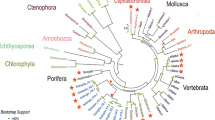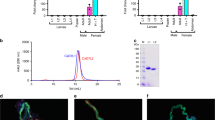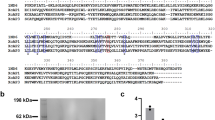Abstract
The nitrophorins are heme-based proteins from the salivary glands of the blood-sucking insect Rhodnius prolixus that deliver nitric oxide gas (NO) to the victim while feeding, resulting in vasodilation and inhibition of platelet aggregation. The nitrophorins also bind tightly to histamine, which is released by the host to induce wound healing. Here we present three crystal structures of nitrophorin 1 (NP1): bound to cyanide, which binds in a manner similar to NO (2.3 Å resolution); bound to histamine (2.0 Å resolution); and bound to what appears to be NH3 from the crystallization solution (2.0 Å resolution). The NP1 structures reveal heme to be sandwiched between strands of a lipocalin-like β-barrel, and in an arrangement unlike any other gas-transport protein discovered to date. The heme is six-coordinate with a histidine (His 59) on the proximal side, and ligand in a spacious pocket on the distal side. The structures confirm that NO and histamine compete for the same binding pocket and become buried on binding. The dissociation constant for histamine binding was found to be 19 nM, ∼100-fold lower than that for NO.
This is a preview of subscription content, access via your institution
Access options
Subscribe to this journal
Receive 12 print issues and online access
$189.00 per year
only $15.75 per issue
Buy this article
- Purchase on Springer Link
- Instant access to full article PDF
Prices may be subject to local taxes which are calculated during checkout
Similar content being viewed by others
References
Ribeiro, J.M.C., Hazzard, J.M.H., Nussenzveig, R.H., Champagne, D.E. & Walker, F.A. Reversible binding of nitric oxide by a salivary heme protein from a bloodsucking insect. Science 260, 539–541 (1993).
Ribeiro, J.M.C. & Walker, F.A. High affinity histamine-binding and antihistaminic activity of the salivary nitric oxide-carrying heme protein (nitrophorin) of Rhodnius prolixus . J. Exp. Med. 180, 2251–2257 (1994).
Andersen, J.F. et al. Nitric Oxide Binding and Crystallization of Recombinant Nitrophorin I, a Nitric Oxide Transport Protein from the Blood-Sucking Bug Rhodnius prolixus . Biochemistry 36, 4423–4428 (1997).
Champagne, D.E. The role of salivary vasodilators in bloodfeeding and parasite transmission. parasitology today 10, 430–433 (1994).
Law, J., Ribeiro, J.M.C. & Wells, M. Biochemical insights derived from diversity in insects. Annu. Rev. Biochem. 61, 87–111 (1992).
Kirchhoff, L.V. American Trypanosomiasis (Chagas' Disease) - A tropical disease now in the United States. N. Engl. J. Med. 329, 639–644 (1993).
Ribeiro, J.M.C., Schneider, M. & Guimaraes, J.A. Purification and characterization of prolixin S (nitrophorin 2), the salivary anticoagulant of the blood-sucking bug Rhodnius prolixus . Biochem. J. 308, 243–249 (1995).
Sun, J. et al. Purification, characterization and cDNA cloning of a novel anticoagulant of the intrinsic pathway (prolixin-S) from salivary glands of the blood sucking bug, Rhodnius prolixus . thrombosis and hemostasis 75, 573–577 (1996).
Bredt, D.S. & Snyder, S.H. Nitric oxide: a physiologic messenger molecule. Annu. Rev. Biochem. 63, 175–195 (1994).
Schmidt, H.H. & Walter, U. NO at work. Cell 78, 919–925 (1994).
Valenzuela, J.G., Walker, F.A. & Ribeiro, J.M.C. A salivary nitrophorin (nitricoxide-carrying hemoprotein) in the bedbug Cimex lectularius . J. Exp. Biol. 198, 1519–1526 (1995).
Jia, L., Bonaventura, C., Bonaventura, J. & Stamler, J.S. S-nitrosohaemoglobin: a dynamic activity of blood involved in vascular control. Nature 380, 221–226 (1996).
Addison, A.W. & Stephanos, J.J. Nitrosyliron(III) hemoglobin: autoreduction and spectroscopy. Biochemistry 25, 4104–4113 (1986).
Sharma, V.S., Traylor, T.G. & Gardiner, R. Reaction of nitric oxide with heme proteins and model compounds of hemoglobin. Biochemistry 26, 3837–3843 (1987).
Levy, J.H. The Human Inflammatory Response. J. Cardiovasc. Pharmacol. 27 (Suppl. 1), S31–S37 (1996).
Mannaioni, P.F., Bello, M.G.D. & Masini, E. Platelets and inflammation: Role of platelet-derived growth factor, adhesion molecules and histamine. Inflamm. Res. 46, 4–18 (1997).
Flower, D.R. The lipocalin protein family: structure and function. Biochem. J. 318, 1–14 (1996).
Newcomer, M.E. et al. The three-dimensional structure of retinol-binding protein. EMBO J. 3, 1451–1454 (1984).
Holden, H.M., Rypniewski, W.R., Law, J.H. & Rayment, I. The molecular structure of insecticyanin from the tobacco hornworm Manduca sexta L. at 2.6 Å resolution. EMBO J. 6, 1565–1570 (1987).
Huber, R. et al. Molecular structure of the bilin binding protein (BBP) from Pieris brassicae after refinement at 2.0 Å resolution. J. Mol. Biol. 198, 499–513 (1987).
Enemark, J.H. & Feltham, R.D. Principles of structure, bonding, and reactivity for metal nitrosyl complexes. Coord. Chem. Rev. 13, 339–406 (1974).
Scheldt, W.R., Lee, Y.J. & Hatano, K. Preparation and structural characterization of nitrosyl complexes of ferric porphyrinates. molecular structure of aquonitrosyl(meso-tetrapheylporphinato)iron(III) perchlorate and nitrosyl(octaethylporphinato)iron(III) perchlorate. J. Am. Chem. Soc. 106, 3191–3198 (1984).
Scheldt, W.R., Brinegar, A.C., Ferro, E.B. & Kirner, J.F. nitrosylmetalloporphyrins. 4. molecular stereochemistry of two crystalline forms of nitrosyl-α,β,γ,—tetraphenylporphinato(4-methylpiperidine)-iron(II). A structural correlation with v(NO). J. Am. Chem. Soc. 99, 7315–7322 (1977).
Deatherage, J.F. & Moffat, K. Structure of nitric oxide hemoglobin. J. Mol. Biol. 134, 401–417 (1979).
Bisig, D.A., Dilorio, E.E., Diederichs, K., Winterhalter, K.H. & Piontek, K. Crystal structure of Asian elephant (Elephas maximus) cyano-metmyoglobin at 1.78-Å resolution. J. Biol. Chem. 270, 20754–20762 (1995).
Mathews, F.S. The orientation of the heme group in crystalline cytochrome b5 . Biochem. Biophys. Acta 622, 375–379 (1980).
Rivera, M. et al. Gene synthesis, bacterial expression, and 1H NMR spectroscopic studies of the rat outer mitochondrial membrane cytochrome b5 . Biochemistry 31, 12233–12240 (1992).
Walker, F.A., Huynh, B.H., Scheldt, W.R. & Osvath, S.R. Models of the cytochromes b. 6. The effect of axial ligand plane orientation on the EPR and mossbauer spectra of low-spin ferrihemes. J. Am. Chem. Soc. 108, 5288–5297 (1986).
Ribeiro, J.M.C. The anitserotonin and antihistamine activities of salivary secretion of Rhodnius prolixus . J. Insect. Physiol. 28, 69–75 (1982).
Champagne, D.E., Nussenzvieg, R.H. & Ribeiro, J.M.C. Purification, partial characterization and cloning of nitric oxide-carrying heme proteins (nitrophorins) from salivary glands of the blood-sucking insect Rhodnius prolixus . J. Biol. Chem. 270, 8691–8695 (1995).
Atkinson, T.P., White, M.V. & Kaliner, M.A. . in Inflammation: basic principles and clinical corelates, 2nd Ed. (eds Gallin, J.I., Goldstein, I.M. & Snyderman, R.) 193–209 (Raven Press Ltd, NY, 1992).
Haendler, B. et al. Expression of active recombinant pallidipin, a novel platelet aggregation inhibitor, in the periplasm of Escherichia coli . Biochem. J. 307, 465–470 (1995).
Messerschmidt, A. & Pflugrath, J.W. Crystal orientation and x-ray pattern prediction routines for area-detector diffractometer systems in macromolecular crystallography. J. Appl. Crystallogr. 20, 306–315 (1987).
Kabsch, W. Evaluation of single-crystal x-ray diffraction data from a position-sensitive detector. J. Appl. Crystallogr. 21, 916–934 (1988).
Colloborative computational project, N. The CCP4 suite: programs for protein crystallography. Acta Crystallogr. D50, 760–763 (1994).
CCP4. The CCP4 Suite: Programs for protein crystallography. Acta Crystallogr. D50, 760–763 (1994).
Otwinowski, Z. MLPHARE - Maximum likelihood heavy atom refinement and phase calculation. in isomorphous replacement and anomalous scattering 80 (SERC Daresbury Laboratory, Warrington, England, 1991).
Cowtan, K. ‘dm’: An automated procedure for phase improvement by density modification. CCP4/ESF-EACBM Newsletter on Protein Crystallography 31, 34–38 (1994).
Read, R.J. SIGMAA - Improved fourier coefficients using calculated phases. Acta Crystallogr. A42, 140–149 (1986).
Jones, A. A graphics model building and refinement system for macromolecules. J. Appl. Crystallogr. 11, 268–272 (1978).
Pflugrath, J.W., Saper, M.A. & Quiocho, F.A. New generation graphics system for macromolecular modeling. in Methods and Applications in Crystallographic Computing (eds Hall, S. & Ashida, T.) 404–407 (Clarendon Press, Oxford, 1984).
Jones, T.A., Zou, J.Y., Cowan, S.W. & Kjelgard, M. Improved methods for building protein models in electron density maps and the location of errors in these models. Acta Crystallogr. A47, 110–119 (1991).
Brunger, A.T., Kuriyan, J, Karplus, M. Crystallographic R-factor refinement by molecular dynamics. Science 235, 458–460 (1987).
Engh, R.A. & Huber, R. Accurate bond and angle parameters for X-ray protein structure refinement. Acta Cryst. A 47, 392–400 (1991).
Brunger, A.T. Free R value: a novel statistical quantity for assessing the accuracy of crystal structures. Nature 355, 472–475 (1992).
Kraulis, P.J. MOLSCRIPT: a program to produce both detailed and schematic plots of protein structures. J. Appl. Crystallogr. 24, 946–950 (1991).
Merritt, E.A. & Murphy, M.E.P. Raster3D Version 2.0 - A program for photorealistic molecular graphics. Acta Crystallogr. D50, 869–873 (1994).
Bacon, D.J. & Anderson, W.F. A Fast algorithm for rendering space-filling molecule pictures. J. Mol. Graphics 6, 219–220 (1988).
Author information
Authors and Affiliations
Rights and permissions
About this article
Cite this article
Weichsel, A., Andersen, J., Champagne, D. et al. Crystal structures of a nitric oxide transport protein from a blood-sucking insect. Nat Struct Mol Biol 5, 304–309 (1998). https://doi.org/10.1038/nsb0498-304
Issue Date:
DOI: https://doi.org/10.1038/nsb0498-304
This article is cited by
-
Effect of the saliva from different triatomine species on the biology and immunity of TLR-4 ligand and Trypanosoma cruzi-stimulated dendritic cells
Parasites & Vectors (2016)
-
A hypothesis of couplet molecules and couplet cells in gastric function and an association with Helicobacter pylori
BMC Gastroenterology (2016)
-
Specific histamine binding activity of a new lipocalin from Hyalomma asiaticum (Ixodidae) and therapeutic effects on allergic asthma in mice
Parasites & Vectors (2016)
-
NMR investigations of nitrophorin 2 belt side chain effects on heme orientation and seating of native N-terminus NP2 and NP2(D1A)
JBIC Journal of Biological Inorganic Chemistry (2014)
-
Interaction of dimeric horse cytochrome c with cyanide ion
JBIC Journal of Biological Inorganic Chemistry (2013)



